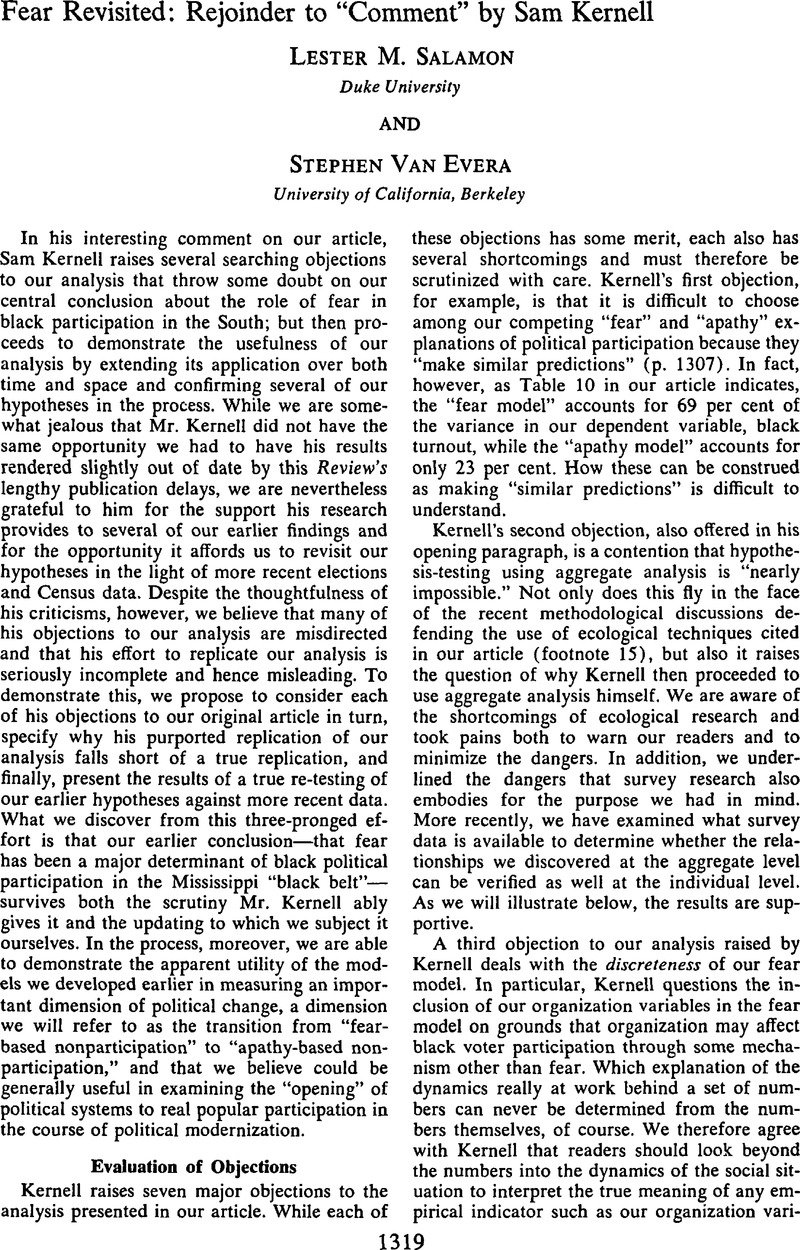Article contents
Fear Revisited: Rejoinder to “Comment” by Sam Kernell
Published online by Cambridge University Press: 01 August 2014
Abstract

- Type
- Reply
- Information
- Copyright
- Copyright © American Political Science Association 1973
References
3 In addition to the differences already cited, Mr. Kernell proceeds differently in defining the vulnerability index. While we used the black voting age population as the denominator in computing this index, Kernell uses the black “labor force,” which subjects his index to the vagaries inherent in the Census definition of the labor force and different cultural patterns among households. The labor force, after all, includes not all adults, but only those employed or “actively seeking work.”
Another departure in Kernell's replication is the use of the eighteen-year-old and over population as the voting age population for computations in connection with the 1971 election, even though the voting age was lowered only a few months prior to the election. Since the younger generation is likely to be generally less responsive to coercion than the older one, the inclusion of this younger element in the computations somewhat prematurely probably understates the influence of the fear-related variables.
Finally, although it is not as central to our own analysis, Kernell's decision to use the Humphrey vote and the Evers vote to measure black turnout in the white majority counties strikes us as somewhat dubious, despite the high correlation between these two votes. In the absence of alternative evidence, the suspicion remains that in counties where the black population is small, local whites might feel at ease enough to vote their economic self-interest and support an economic liberal. Otherwise we would have to believe, for example, that an astounding 76 per cent of the 1,199 voting age blacks in Harrison County trooped to the polls to vote for Hubert Humphrey in 1968. Certainly a substantial share of these votes must have been cast by whites.
4 The data for the independent variables came from U.S. Census of Population, 1970, General Social and Economic Characteristics: Mississippi, No. 26; and the U.S. Census of Agriculture, 1969, Vol. 1, Area Reports, Part 33, Mississippi. In addition, we used the “organizer scores” collected earlier in connection with the original research for our article.
Unfortunately, the Socio-Economic Status (SES) index used to measure occupational status in our original “apathy” model has not yet been computed for 1970 and had to be dropped from the analysis. Given the high correlation between the SES index and education, however, the effect of this is probably slight.
We were also unable to include in our vulnerability index the workers employed outside their county of residence, since figures on this variable were not reported in the 1970 Census.
Except for these alterations, the analysis presented here mirrors that reported in our original article.
5 When these models are computed using the twenty-one-year-old and over—instead of the eighteen-year-old and over—population as the base, the “spread” between these two models increases, with the fear model accounting for 55 per cent of the variance and the apathy model for 45 per cent. Since the voting age was lowered to 18 only a few months before the 1971 election, there is reason to believe the twenty-one and over population is the more accurate one to use. We have nevertheless reported the results using the eighteen and over population in our Table 2 in order to conform to Mr. Kernell's methodology.
6 Our own index of civil rights movement activity was explicitly designed to avoid this problem by measuring movement activity directly instead of in terms of its hypothesized results. Yet Mr. Kernell neglects any mention of our organizer index.
- 2
- Cited by



Comments
No Comments have been published for this article.